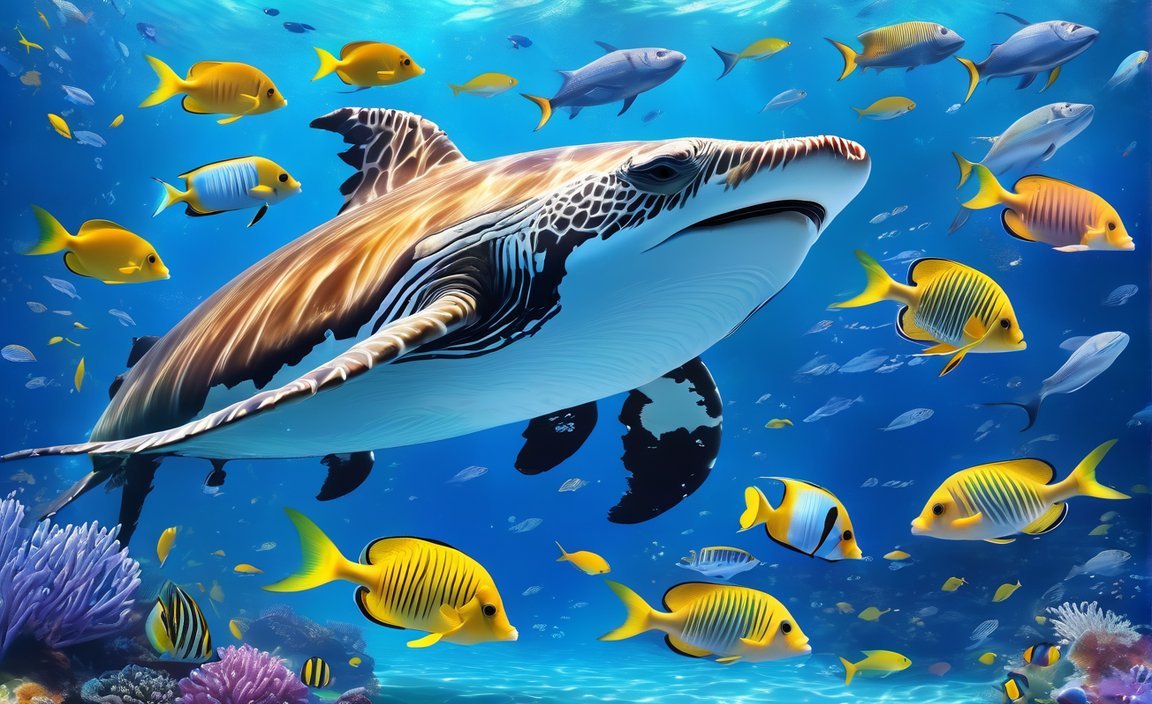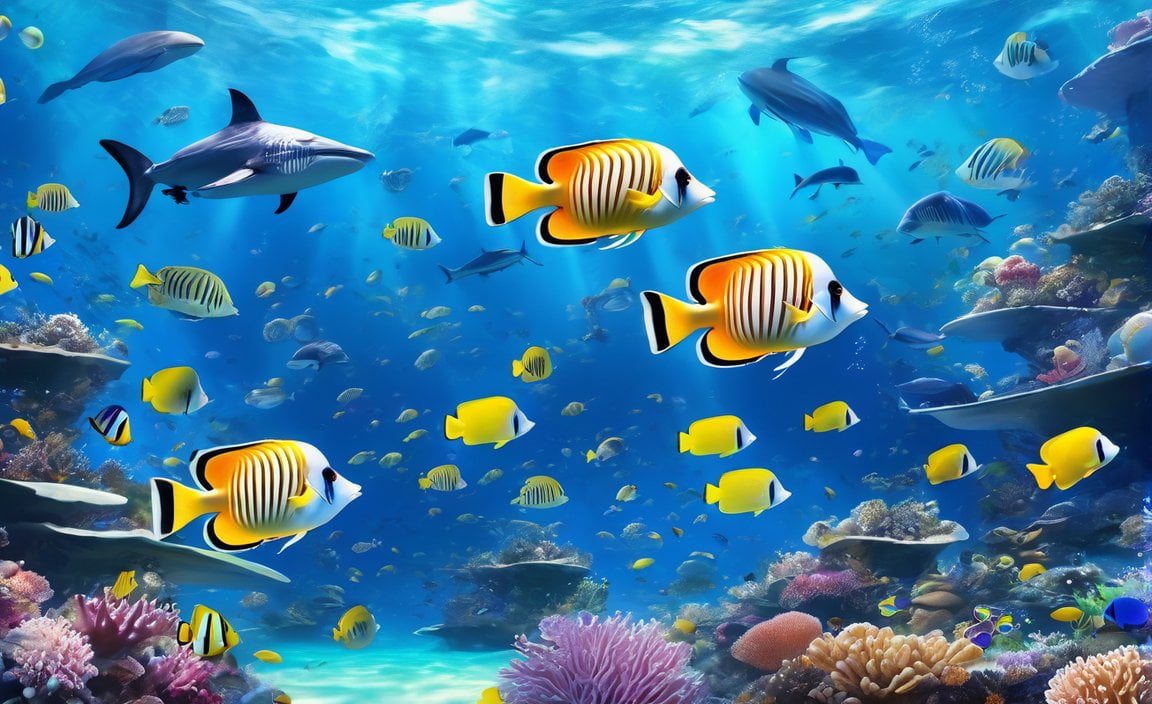Welcome to an enchanting journey into the depths of the ocean! In this article, we will delve into the captivating realm of marine life and uncover an array of amazing facts that will leave you astounded. From the mesmerizing bioluminescent creatures that illuminate the dark abyss to the awe-inspiring intelligence displayed by dolphins and octopuses, prepare to be amazed. Join us as we embark on a voyage of discovery, exploring the wonders that lie beneath the waves in our search for the most enchanting and lesser-known facts about marine life.
Key Takeaways:
- Speed of Sound: The speed of sound in water is nearly five times faster than in the air, reaching an astonishing 1,435 m/sec. It surpasses even the speed of a fighter jet.
- Living Space: The oceans cover 99% of the planet’s living space, harboring 50-80% of all life on Earth. This emphasizes the significance of marine ecosystems.
- Ancient Jellyfish: Jellyfish have been existing for over 650 million years, predating dinosaurs and even sharks. They have adapted to various environments and conditions.
- Electric Eel: The electric eel can generate enough electrical charge to light up to 10 electric bulbs, showcasing the remarkable power of marine life.
These intriguing facts underscore the unique and diverse nature of marine life and emphasize its vital role in the Earth’s ecosystem.
Amazing Facts About Marine Life

The world beneath the waves is a realm of fascinating wonders and extraordinary discoveries. From the depths of the abyss to the sunlit shallows, marine life never fails to amaze us with its astounding diversity and captivating behaviors. Join me on a journey to uncover some incredible and amazing facts about marine life.
1. Speed of Sound:
Did you know that sound travels at an astonishing speed in water? It zips through the liquid realm at approximately 1,435 meters per second, nearly five times faster than in the air. To put it into perspective, it’s even faster than a fighter jet soaring through the sky. The oceans are alive with a symphony of sounds, from the songs of humpback whales to the clicks and whistles of dolphins.
2. Living Space:
The vastness of the oceans dominates the planet’s living space, providing an astonishing 99% of it. These sprawling aquatic realms harbor between 50% to 80% of all life on Earth. From the microscopic plankton that forms the foundation of the marine food chain to the massive whales that roam the open waters, the importance of marine ecosystems cannot be overstated. Our very existence depends on the health and balance of these fragile underwater worlds.
3. Ancient Jellyfish:
Jellyfish have been gracefully drifting through the oceans for over 650 million years, predating dinosaurs and even sharks. These seemingly delicate creatures have adapted and thrived in a multitude of environments and conditions, earning their rightful place as one of the longest-surviving species on our planet. Their mesmerizing forms and intriguing life cycles continue to fascinate scientists and nature lovers alike.
4. Electric Eel’s Shocking Power:
Prepare to be electrified by the astonishing power of the electric eel. In the murky depths of South American rivers, this remarkable creature produces a shocking amount of electricity. A fully charged electric eel is capable of generating enough electrical energy to simultaneously light up to 10 electric bulbs. It’s a stunning display of nature’s innate capabilities and an example of how marine life continues to surprise us.
These are just a few glimpses into the intriguing world of marine life. Each discovery further reinforces the uniqueness and resilience of the underwater realm. As we delve deeper into the mysteries of the oceans, there’s no doubt that more amazing facts about marine life await us, reminding us of the boundless wonders that lie beneath the waves.
Learn More:
Now that you’ve caught a glimpse of the enchanting world of marine life, dive deeper into the oceans of knowledge by exploring these resources.
(Keywords: amazing facts about marine life)
If you’re fascinated by the wonders of aquatic life, check out these amazing facts about aquatic animals. You won’t believe the incredible adaptations and behaviors that these creatures have developed over time. Dive into a world of underwater marvels and discover more about the fascinating marine inhabitants here.
Are you a pet lover? Prepare to be amazed by these amazing facts about cats and dogs! From their unique communication styles to their incredible senses, these furry friends have lots of surprises in store for you. Uncover the secrets of our beloved companions and embark on an adventure of feline and canine wonder here.
Whether you’re a cat aficionado or just curious about these furry creatures, you’ll want to explore the amazing facts about cats and kittens. From their mysterious behaviors to their extraordinary athleticism, cats will leave you mesmerized. Uncover the captivating world of these graceful felines here.
Get ready to dive into the depths of the ocean and discover some truly amazing facts about marine animals. From the graceful movements of dolphins to the majestic presence of whales, the marine world is full of wonders waiting to be explored. Take a plunge into the captivating universe of marine creatures here.
3. Some species of deep-sea anglerfish have a bioluminescent lure that dangles in front of their mouths to attract prey.

The mysterious world of the ocean holds countless fascinating secrets, and one of its most enchanting inhabitants is the deep-sea anglerfish. These remarkable creatures have developed a unique adaptation to lure their prey in the dark abyss. Some species of deep-sea anglerfish have a bioluminescent lure that dangles in front of their mouths to attract prey.
In the depths of the ocean, where sunlight barely penetrates, anglerfish have evolved an ingenious technique to compensate for the lack of visibility. The female anglerfish possesses a luminescent lure called the esca which hangs in front of her mouth. This mesmerizing appendage acts as a beacon, drawing unsuspecting prey towards the anglerfish’s toothy jaws.
The esca of the anglerfish emits a gentle glow, reminiscent of a distant star in the night sky. This ethereal light is created through a symbiotic relationship with luminescent bacteria that reside within the esca. These bacteria produce an enzyme called luciferase, which reacts with a specific molecule to create the bioluminescence. The exact number of unique species of luminescent bacteria associated with anglerfish is still unknown, adding to the allure and mystique of these deep-sea dwellers.
It’s important to note that not all anglerfish species possess such elaborate lures. While some have relatively simple lures with just one dot of light on the tip, others boast more complex and elaborate structures. The diversity of anglerfish lures reflects the incredible adaptability and evolution that occurs within the deep-sea ecosystem.
The glowing lure of the anglerfish serves as an irresistible temptation for unsuspecting prey. In the vast darkness of the ocean depths, this alluring light becomes a beacon of hope for creatures seeking food. As prey approach the luminous lure, they become ensnared in the anglerfish’s toothy mouth, falling victim to their cleverly orchestrated trap.
It is worth mentioning that anglerfish are top predators in their habitats. Their unique feeding strategy allows them to consume prey larger than themselves, thanks to their expandable stomachs. With a single gulp, an anglerfish can swallow prey that would seem impossibly large for its size.
The mysteries of deep-sea anglerfish didn’t stop at their feeding habits. Recently, the mating behavior of these fascinating creatures has been captured on film, providing valuable insights into their reproductive process. Deep-sea anglerfish exhibit extreme sexual dimorphism, where the males are much smaller than the females. In a truly bizarre reproductive strategy, the tiny male anglerfish attaches itself to the female as a parasite. This unusual arrangement allows the male to access the female’s nutrients and ensure the survival of their offspring.
In conclusion, the deep-sea anglerfish’s bioluminescent lure is an astonishing adaptation that showcases the marvels of nature’s ingenuity. The glow emanating from their lures creates a mesmerizing spectacle in the dark depths of the ocean, luring unsuspecting prey closer to their waiting jaws. Through their remarkable evolutionary adaptations and extraordinary behavior, anglerfish remind us of the wonders that lie beneath the waves, inviting us to immerse ourselves in the fascinating world of marine life.
Key Takeaways:
– Some species of deep-sea anglerfish possess a bioluminescent lure called the esca to attract prey.
– The esca emits a gentle glow, created through a symbiotic relationship with luminescent bacteria.
– The exact number of unique species of luminescent bacteria associated with anglerfish is unknown.
– Anglerfish with different lure structures demonstrate the adaptability within deep-sea ecosystems.
– The anglerfish’s bioluminescent lure serves as a beacon to draw prey closer, enabling the anglerfish to consume prey larger than themselves.
– Anglerfish exhibit extreme sexual dimorphism, with tiny males attaching themselves as parasites to larger females during mating.
– Recent filming of deep-sea anglerfish mating behavior provides valuable insights into their reproductive process.
Sources:
– National Geographic: Bioluminescent Anglerfish
– Smithsonian National Museum of Natural History: How Anglerfish Use Bioluminescence to Survive
4. Dolphins: Masters of Communication
Dolphins are highly fascinating creatures that capture the imagination with their intelligence and remarkable ability to communicate. These charismatic marine mammals have a complex system of communication that involves clicks, whistles, and body language. Let’s dive deeper into the world of dolphins and discover the enchanting facts about their intelligence and communication skills.
Dolphins: The Masters of the Ocean
- Dolphins have captivated researchers and marine biologists with their advanced cognitive abilities and social behavior.
- They live in social groups called pods, which can consist of a few individuals to hundreds of dolphins depending on the species and location.
- The members of a dolphin pod display strong social bonds and exhibit cooperative behaviors, such as hunting and caring for young calves.
A Language of Clicks, Whistles, and More
- Dolphins communicate using a variety of vocalizations, including clicks, whistles, and body language.
- These vocalizations serve different purposes, such as social interactions, hunting strategies, and navigation.
- Clicks are short, high-pitched sounds that dolphins produce through their nasal passages. These clicks are used for echolocation, enabling dolphins to navigate and locate prey in their surroundings with remarkable precision.
- Whistles, on the other hand, are longer and more tonal sounds that dolphins create using their blowhole. Whistles are believed to convey emotional states, individual identification, and social bonding within the pod.
- Body language, including tail slaps, breaches, and leaping, also plays a significant role in dolphin communication. These physical movements convey information about dominance, aggression, playfulness, and courtship rituals.
The Complexity of Dolphin Communication
- One of the most intriguing aspects of dolphin communication is their ability to distinguish between individual pod members. Each dolphin has a unique set of vocalizations, like a signature whistle, that functions as their own “name” within the pod.
- Dolphins can remember and recognize these signature whistles, allowing them to call out to specific individuals in their pod, even when they are spread out over long distances.
- These intelligent marine mammals can also engage in coordinated vocalizations, creating a synchronized chorus of whistles and clicks within their pod.
- In captivity, dolphins have been trained to respond to hand signals and gestures from trainers. However, in the wild, their communication relies primarily on these fascinating vocalizations and nonverbal cues.
The Wonders of Dolphin Intelligence
- Dolphins possess sophisticated cognitive abilities that rival those of primates, such as problem-solving, learning, and self-awareness.
- They have remarkable memory and can remember relationships with other dolphins, as well as learned behaviors and hunting techniques.
- Studies have shown that dolphins can comprehend and respond to human language cues, demonstrating their ability to understand complex concepts and mimic human speech patterns.
- Their social behavior and intelligence have led scientists to compare dolphins to highly intelligent beings, challenging our understanding of various forms of intelligence in the animal kingdom.
Key Takeaways:
- Dolphins have an extensive and complex communication system that allows them to distinguish between individual pod members.
- They communicate through pulses, clicks, whistles, and body language.
- Dolphins use a variety of vocalizations and echolocation to communicate with each other and navigate their environment.
- They live in social groups called pods and use a complex system of vocalizations to communicate.
- Dolphins are known to be highly intelligent animals with the ability to exhibit complex social behaviors and communication.
- Their anatomy is unique and allows them to thrive in their aquatic environment.
- Dolphins have a strong sense of empathy, altruism, and attachment and enjoy playing and seeking companionship.
- They have their own individual “names” in the form of signature whistles that they use to greet each other.
Source:
– American Oceans. “How Smart Are Dolphins.”
– National Geographic. “It’s Time for a Conversation.”
5. Octopuses: Masters of Camouflage and Adaptation
Key Takeaways:
– Octopuses possess the remarkable ability to change the color and texture of their skin for camouflage and communication purposes.
– Their skin contains specialized pigment cells called chromatophores, which can expand or contract to alter their color instantly.
– Octopuses, along with squids and cuttlefish, are the only animals capable of changing the color of their skin.
– This camouflage skill allows them to seamlessly blend into their surroundings and hide from predators or potential threats.
– In addition to their color-changing abilities, octopuses’ skin can also sense and respond to light directly, adding another dimension to their mastery of camouflage and communication.
– Octopuses are highly intelligent creatures, capable of problem-solving, learning, and even using tools in certain situations.
– They have a carnivorous diet and feed on a variety of prey, including crabs, shrimp, fish, and other small marine organisms.
Octopuses are truly fascinating creatures, known for their extraordinary camouflage abilities. These enigmatic beings can change the color and texture of their skin to blend seamlessly into their surroundings, making them masters of disguise in the ocean depths.
Through the use of specialized pigment cells called chromatophores, octopuses can instantly alter the color and pattern of their skin. These chromatophores can expand or contract, allowing the octopus to match the exact hues and patterns of its environment. This remarkable ability not only helps them blend in with their surroundings but also serves as a means of communication with other octopuses.
Octopuses, along with squids and cuttlefish, are among the few animals capable of such rapid and precise color changes. Their skin is adorned with thousands of chromatophores located just below the surface, enabling them to transform and adapt in an instant.
This extraordinary talent for camouflage serves multiple purposes in an octopus’s life. It allows them to hide from predators that may be lurking in the depths, evading potential threats and ensuring their survival. It also aids in their hunting strategies, allowing them to approach prey undetected.
But their mastery of camouflage doesn’t stop at their ability to change color. Octopuses’ skin is also equipped with the ability to sense and respond to light independently of their eyes or brain. This means that an octopus can perceive light through its entire body, further enhancing its camouflage capabilities and providing a deeper understanding of the environment.
Beyond their impressive camouflage skills, octopuses are renowned for their high level of intelligence. They possess the cognitive abilities to problem-solve, learn from experience, and even use tools in certain situations. This exceptional intelligence has captivated the attention of scientists, who continue to study and unravel the depths of their cognitive prowess.
In terms of their diet, octopuses are carnivorous creatures that feed on a variety of prey. Their flexible bodies and powerful suckers allow them to capture and consume a range of marine organisms, including crabs, shrimp, fish, and other small creatures. They are skilled hunters, strategically utilizing their camouflage and dexterity to secure their next meal.
In conclusion, octopuses are truly remarkable creatures that have perfected the art of camouflage. Their ability to change the color and texture of their skin allows them to seamlessly blend into their surroundings, whether for protection or concealment during hunting. Alongside their impressive camouflage skills, their intelligence and carnivorous diet make them intriguing subjects of scientific research. Octopuses continue to surprise and awe us with their fascinating adaptations and behaviors, reaffirming the enchanting wonders that lie beneath the waves.
Sources:
– Ocean Fauna – Can Octopus Change Color? Explained
– EarthSky – An octopus senses light with its skin
FAQ
Q1: What is the speed of sound in water compared to the speed of sound in air?
A1: The speed of sound in water is nearly five times faster than the speed of sound in air, reaching an astonishing 1,435 m/sec.
Q2: How much of the planet’s living space do the oceans provide?
A2: The oceans dominate 99% of the planet’s living space, making them the primary contributors to the Earth’s habitats.
Q3: How long have jellyfish been around?
A3: Jellyfish have been around for over 650 million years, predating the existence of dinosaurs and sharks.
Q4: What impressive ability does the electric eel have?
A4: The electric eel has the remarkable capability to produce electricity. It can generate enough electrical charge to light up to 10 electric bulbs.
Q5: How do octopuses change color and texture?
A5: Octopuses change color and texture through the use of specialized pigment cells in their skin called chromatophores. These cells can expand or contract to alter the color of their skin, allowing them to camouflage and communicate.
- Unraveling Einstein’s Legacy: Who Inherited His Genius? - July 14, 2025
- Unlock Einstein’s Family Tree: Bernhard Caesar & Untold Stories - July 14, 2025
- Unveiling Bernhard Caesar Einstein: His Life & Albert Einstein’s Legacy - July 14, 2025
















